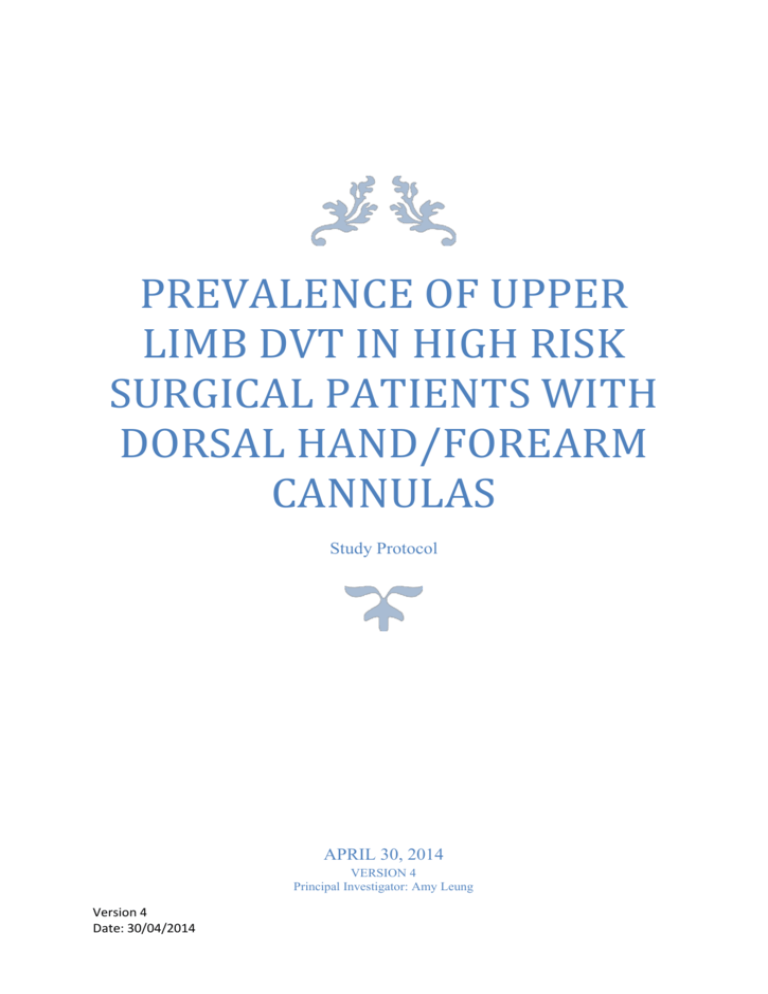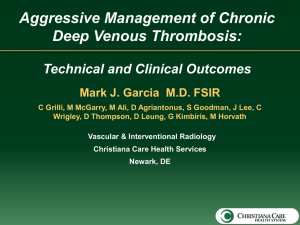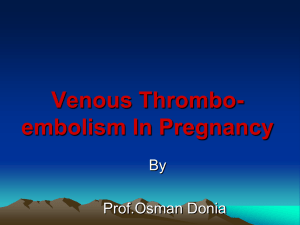Prevalence of upper limb DVT in high Risk Surgical patients
advertisement

PREVALENCE OF UPPER LIMB DVT IN HIGH RISK SURGICAL PATIENTS WITH DORSAL HAND/FOREARM CANNULAS Study Protocol APRIL 30, 2014 VERSION 4 Principal Investigator: Amy Leung Version 4 Date: 30/04/2014 Page |1 1.0 Study Title Prevalence of upper limb DVTs in high risk surgical patients who have received dorsal or forearm cannulas. 2.0 Study Investigators Principal Investigator: Amy Leung (Year 6 Student in Medicine) School of Medicine and Dentistry James Cook University Mackay QLD 4740 M: 0448904844 Email: amy.leung@my.jcu.edu.au Clinical Supervisor: Dr Casper F Pretorius MBChB, MMED Surgery, FCS SA, FRACS General Surgeon & Clinical Director Surgery Mackay Base Hospital School of Medicine and Dentistry James Cook University Mackay QLD 4740 P: +61-7-49686000 Email: casper.pretorius@health.qld.gov.au Academic Supervisor: Associate Professor Clare Heal MBChB, DRANZCOG, DipGUMed, FRACGP, MPHTM, PhD Associate Professor in General Practice and Rural Medicine School of Medicine and Dentistry James Cook University Mackay QLD 4740 Email: clare.heal@jcu.edu.au Version 3 Date: 15/04/2014 Page |2 Contents 1.0 Study Title ......................................................................................................................................... 1 2.0 Study Investigators............................................................................................................................ 1 3.0 Introduction ...................................................................................................................................... 3 4.0 Background ....................................................................................................................................... 3 5.0 Objectives.......................................................................................................................................... 4 5.1 Study Objective/Aim ..................................................................................................................... 4 6.0 Hypothesis......................................................................................................................................... 4 7.0 Study Design...................................................................................................................................... 4 8.0 Study Setting ..................................................................................................................................... 4 9.0 Study Population ............................................................................................................................... 5 9.1 Eligibility Criteria ........................................................................................................................... 5 10.0 Study Assessment and Procedures ................................................................................................. 6 10.1 Study Procedure.......................................................................................................................... 6 10.2 Sonography ................................................................................................................................. 7 10.3 Safety management .................................................................................................................... 7 10.4 Adverse events ............................................................................................................................ 7 10.5 Withdrawal from study ............................................................................................................... 8 11.0 Statistical Considerations ................................................................................................................ 8 11.1 Sample Size ................................................................................................................................. 8 11.2 Statistical Analysis ....................................................................................................................... 8 12.0 Study timeline ................................................................................................................................. 9 13.0 Ethical requirements ..................................................................................................................... 11 13.1 Declaration of Helsinki .............................................................................................................. 11 13.2 Ethical considerations ............................................................................................................... 11 13.3 Informed Consent ..................................................................................................................... 11 13.4 Patient information protection ................................................................................................. 11 13.5 Aboriginal and Torres Strait Islander patients .......................................................................... 11 14.0 Outcomes and Significance ........................................................................................................... 12 15.0 References .................................................................................................................................... 13 Version 3 Date: 15/04/2014 Page |3 3.0 Introduction Pulmonary embolisms have a mortality rate of 15%. Twenty percent of all pulmonary embolisms have an unknown source. It may be suggested that these arise from the upper limb. The aim of this study is to determine if there is an association between dorsal hand/forearm cannulas and upper limb DVTs. 4.0 Background Approximately 10% of all deep vein thrombosis cases occur within the upper limb.(1) This figure may actually be an underestimation as many upper limb DVTs are clinically silent.(2) An upper limb deep vein thrombosis (DVT) refers to the formation of a fibrin clot within the subclavian, axillary and brachial veins of the arm. (3) Upper limb DVTs are classified as either a primary or secondary deep vein thrombosis depending on its aetiology. A primary upper limb DVT is either idiopathic or effort related and are considered to be rare. This study will focus on secondary upper limb DVTs which is where the thrombosis occurs in the presence of a known risk factor. Risk factors which have been identified by previous studies include the use of central venous catheters, malignancy, immobilization of the upper limb, obesity and pregnancy.(3) DVTs can also be classified as either asymptomatic or symptomatic. An asymptomatic DVT is classified as a DVT detected during a diagnostic procedure for screening purposes that produces no clinical symptoms. A symptomatic DVT is one which is diagnosed in the context of having clinical symptoms including pain, swelling and erythema.(1) Upper limb DVTs have a considerable morbidity and mortality rate due to its potential complications. Previous studies have shown that up to 33% of patients with an upper limb DVT will develop a pulmonary embolism.(4) The mortality rate from a pulmonary embolism has shown to be between 15-50%.(5) Unfortunately the incidence of upper limb DVTs has seen to be increasing. This has been attributed to the increased use of peripherally inserted central catheters (PICCs) and central venous catheters (CVCs) as more patients require long term venous access for intravenous antibiotics, ease of blood draws and chemotherapy.(6) The incidence of CVC related asymptomatic thrombosis has been reported to be as high as 66%. Additionally a prospective study conducted on 89 cancer patients showed that the incidence of PICC related upper limb DVT was 45.6%.(7) Various factors are involved in the development of the upper limb DVT including vessel wall injury caused by the insertion of the catheter, venous stasis from catheter placement and vessel occlusion due to the comparatively large catheter lumen to the smaller upper limb veins.(8) While there is quite an extensive amount of literature available on the topic of CVC or PICC related thrombosis, there are currently no studies to our knowledge on cannula related deep vein thrombosis. We have chosen our study as intravenous cannulas are used frequently in hospitals to deliver blood and blood products, drugs, parenteral nutrition and fluid therapy (9) with preferred site for these cannulas being the veins of the dorsal hand and the forearm.(10) Similarly to PICCs and CVCs, it is suggested that cannulas cause irritation of the vein and stasis of blood flow.(11) Therefore there is the potential for cannulas inserted within the superficial veins of the dorsal hand/forearm could lead to the development of an upper limb DVT. Version 3 Date: 15/04/2014 Page |4 5.0 Objectives 5.1 Study Objective/Aim To investigate the relationship between dorsal hand/forearm cannulas and the development of an upper limb DVT in high risk surgical patients. 5.1.1 Primary Objective To identify upper limb DVTs in high risk surgical patients who receive dorsal hand or forearm cannulas. 5.1.2 Secondary Objective To determine if the clinical symptoms and signs of the upper limb DVT correlates with ultrasound findings 6.0 Hypothesis Virchow’s Triad states that thrombosis is caused by stasis, hypercoagulability and endothelial injury. In high risk surgical patients with stasis and hypercoagulability (from malignancy, thrombophilias, previous surgery or trauma and aged over 65 years), it is hypothesized that a cannula in the superficial veins of the hand or forearm, may cause endothelial injury, to complete the triad. 7.0 Study Design This will be a cross sectional observational study. 8.0 Study Setting This will be a single centre study conducted within the general surgical unit of Mackay Base Hospital. Version 3 Date: 15/04/2014 Page |5 9.0 Study Population Participants will be recruited from the general surgical unit at Mackay Base Hospital. The principal investigator screen all patients over aged 65 within the general surgical unit to determine if they fit the inclusion and exclusion criteria to classify as a high risk surgical patient for the study. The objective is to enrol 62 participants over the course of 1 year. All patients will be on DVT prophylaxis as part of normal surgical patient care. 9.1 Eligibility Criteria a) Inclusion Criteria 65 years or older a cannula in forearm/dorsum of the hand, inserted on admission FBC and INR performed on admission Patients with one or more of the following criteria: underlying malignancy thrombophilias (Factor C deficiency, Factor S deficiency, Factor 5 Leiden mutation, Anti thrombin 3 deficiency, anti-phospholipid syndrome, Prothrombin 20210A mutation) previous surgery or trauma A high risk surgical patient will be classified as a patient with two or more risk factors (one of the risk factors will be aged over 65). b) Exclusion Criteria previous or current trauma of upper limb or chest previous or current upper limb, neck or axillary surgery previous or current upper limb DVT previous mastectomy thoracic outlet syndrome enlarged lymph nodes/tumours causing upper limb venous compression Version 3 Date: 15/04/2014 Page |6 10.0 Study Assessment and Procedures 10.1 Study Procedure 1) All patients in the general surgical unit at Mackay Base Hospital over the age of 65 years, will be screened for eligibility. These patients will be entered on to a Screening Log. Patients will be deidentified on the screening log to retain confidentiality. Patients will be given a number to ensure confidentiality. 2) Patients meeting inclusion and exclusion criteria will be invited to participate in the study by the principle investigator. 3) Dr Casper Pretorius (Clinical supervisor) will explain the nature of the study to the patient and obtain an informed consent. 4) The study patient will be enrolled into the study and allocated a study specific number. This number will consist of a 3 numbers, starting at 001, and 3 letters. The letters will be the first letter of first 2 names and first letter of last name. (e.g. 001 ABC) 5) A patient Identification log will be completed. This will have the study specific number, the patient’s full name and surname entered. This document will be kept confidential and stored separately and a safe location. This information is only available to the 3 Study Investigators. 6) A case report form (CRF) will be compiled and completed for each patient on the study. All study related data will be collected by Amy Leung and entered into the CRF. Data collected onto the CRF will include patient demographics (age, gender, ethnicity), height and weight, past medical history, type of malignancy, type of thrombophilia, length of surgery, type of trauma, FBC and INR results, type of cannula inserted, date of cannula insertion, number of attempts of cannula insertion, size of the cannula and location of the cannula. The patient’s obtained consent will also be recorded. This information will be recorded onto a hard copy of an excel spreadsheet and onto the SPSS system. The hard copy will be stored in a locked cupboard at the JCU clinical school. 7) Each patient will have a colour duplex ultrasound at the start of the study, as a baseline investigation. 8) On days 2-29 of the study the principal investigator will visit the patient twice a day (this will occur only while the patient remains a Mackay Base Hospital inpatient) to obtain the following information -History: questions relating to the study such as if the patient has noticed any pain in the arm, shortness of breath or feeling unwell -Examination: vitals (according to the Adult Deterioration Detection Chart score), any signs of an upper limb DVT including erythema, swelling, tenderness on palpation, any signs of a pulmonary embolism including shortness of breath and pleuritic chest pain 9) Each patient will have a second colour duplex ultrasound at discharge, to determine if an upper limb DVT has developed. If the patient is still an inpatient at day 30 of enrolment of the study they will have a second ultrasound on day 30. A patient will have an earlier second ultrasound if they develop clinical symptoms or signs of an upper limb DVT (including pain, swelling, erythema and tenderness on palpation) to ensure adequate management of a potential upper limb DVT. If an upper limb DVT is found on either the first or second ultrasound patients will be treated as per standard DVT treatment protocol at Mackay Base Hospital as part of good clinical practice. Version 3 Date: 15/04/2014 Page |7 10) All patients will be followed up for 30 days from the time of enrolment into the study. If the patient remains an inpatient the principal investigator will review them in hospital. Patients who were discharged prior to day 30 will be followed up with an outpatient surgical appointment at day 30. 10.2 Sonography We have selected colour duplex ultrasound to determine the diagnosis of upper limb DVT as it has a sensitivity between 78-100% and a specificity between 82-100% according to a reference test by Pradoni.(12) We acknowledge that there will be some variability with the results depending upon the sonographer. The duplex ultrasound results from enrolment and the results at discharge will be recorded onto the spreadsheet. The veins that will be examined will include the following deep veins: bilateral brachial, axillary, and subclavian veins The criteria for an upper limb DVT on a colour duplex ultrasound include one or more of the following: thrombus found lack of flow non-pulsatile and non-phasic flow lack of compressibility of veins All investigators in the study will use this criteria to identify upper limb deep vein thrombosis. The ultrasounds will be performed by an independent trained sonographer to eliminate bias. 10.3 Safety management A patient with the diagnosis of an upper limb DVT on first or second ultrasound, will be identified and treated according to standard DVT treatment protocol at Mackay Base Hospital as part of good clinical practice. 10.4 Adverse events An adverse event will be defined as the development of any undesired medical condition. For example this could be an abnormal investigation result, deterioration in a previous medical condition and more specifically for this study the signs and symptoms of an upper limb DVT or pulmonary embolism. These patients will be reviewed twice daily in-hospital and on Day 30 of the study for any adverse events. The patients will be assessed by their history, examination and vitals according to the Adult Deterioration Detection Chart (ADDs score) which is located in every Queensland Health patient chart. Any ADDs score over 1 will be reported to the nurse in charge of the patient. Patients will be asked “ How are you today? Is your health any different to the previous visit?” to determine verbally if an adverse event has occurred. Any adverse event will be recorded in the CRF. Patients found to have Version 3 Date: 15/04/2014 Page |8 adverse events will be reported to Dr Casper Pretorius (Clinical supervisor and Director of Surgery) to be treated according to Queensland Health Protocol. 10.5 Withdrawal from study Patients can decide to discontinue from the study at any time. Patients will be withdrawn from study if: Insertion of central venous or PICC-line is required Axillary, neck or upper limb surgery is required 11.0 Statistical Considerations 11.1 Sample Size The sample size estimates were based on the results of previous studies conducted on the prevalence of upper limb DVT in patients with malignancy who received central lines and PICC lines. We estimated that the expected prevalence of DVT is 20%. Using the sample size calculation, it was estimated that for a 95% confidence interval of 15-25% a sample size of 246 participants was required. For 95% CI of 10-30% a sample size of 62 participants will be our aim. 11.2 Statistical Analysis Data analysis will be performed using SPSS. Descriptive statistics will be generated. Parametric data will be expressed as means +/- standard deviations while the non-parametric data will be expressed as medians and quartile ranges. Dichotomous variables will be analysed using the chi squared test. Dichotomous versus continuous variables will be analysed using the t tests if the data is parametric, and Mann-Whitney if the data is non parametric. Version 3 Date: 15/04/2014 Page |9 12.0 Study timeline Day of Study Time of day Procedures performed Data Recorded in CRF Complete Visit 1 Study related: Patient information, Day 1 Time of enrolment First Sonargraphy Enrol into Study History, Physical examination, Special Investigations performed according to CRF 1) Morning Day 2 to Day 29/Day prior to Discharge (In-hospital) History Complete Visit 2 - (after ward round) Vitals: ADDS score Visit 30/Discharge (08:00-10:00am) Focussed examination Study related: History, 2) Afternoon (16:00-18:00) History Vitals (ADDS Score), Vitals: ADDS score Focussed examination Focussed examination according to CRF Complete Discharge Visit Second Sonargraphy Day of Discharge (if prior to Day 30) Prior to Discharge Study related: History, Appointment Date Vitals (ADDS Score), for Follow-up on Day 30 Focussed examination (30 days after admission date) according to CRF Complete Day 30 Visit Study related: Version 3 Date: 15/04/2014 P a g e | 10 Day 30 Second Sonargraphy (In Hospital) History, Vitals (ADDS Score), Focussed examination according to CRF Complete Day 30 Visit as Follow up Day 30 (if patient discharged before Day 30) Time of appointment Patient will be phoned by the principal investigator a day prior to the appointment to be reminded Out Patient Study related: History, Vitals (ADDS Score), Focussed examination according to CRF Version 3 Date: 15/04/2014 P a g e | 11 13.0 Ethical requirements 13.1 Declaration of Helsinki The study will abide by the Declaration of Helsinki. At all times during the study the participant’s welfare will always be the first priority. Ethical considerations will also take precedence over any laws and regulations as mentioned within the Declaration of Helsinki. 13.2 Ethical considerations Information regarding the safety of ultrasounds will be found on the patient information sheet. Patients may experience mild discomfort with the ultrasound probe. Any adverse events will be monitored by the principal investigator who will review the participants twice a day while they remain as an inpatient. This study will be carried out according to the ethical principles in the Declaration of Helsinki and the NHMRC National Statement of Ethical Conduct of Research Involving Humans (1999). 13.3 Informed Consent Screened patients who are deemed eligible for the study and express an interest in participating in the study will have the nature of the study explained to them. The patients will also be given a patient information sheet for them to peruse. Once the investigator is assured that the patient understands the nature of the study and any possible implications associated with enrolling in the study, the investigator will then to obtain consent from the patient by asking the patient to read and sign the informed consent form. The participant’s consent for the study will be recorded on their CRF. The investigator will keep a copy of the participants consent form in a locked cupboard and a copy will be provided to the participant. 13.4 Patient information protection To protect patient information the participant will receive an identifying number. The list of participant names and the identifying number will be kept separate from the list of the identifying numbers and the collected data. To protect the privacy of the patients all data will be locked away when not in use in a locked cupboard at the JCU Clinical School. Only the investigators in the study will have access to this data (Amy Leung, Dr Casper Pretorius, Dr Clare Heal). 13.5 Aboriginal and Torres Strait Islander patients There may be a probable coincidental recruitment of Aboriginal and Torres Strait Islander patients. Other than the two ultrasounds and a follow-up review at 30 days post enrolment into the study there is no deviation from standard care. Version 3 Date: 15/04/2014 P a g e | 12 14.0 Outcomes and Significance 1) To determine if patients with dorsal hand/forearm cannulas develop upper limb DVT in patients who are identified as high risk for DVT formation. 2) If the incidence of upper limb DVT proves to be higher in this group of patients, additional prophylaxis like sequential compression devices could be advised 3) To identify the prevalence of silent upper extremity DVT in this group of patients 4) The incidence of pulmonary embolism in this subset of patients, and the need for prolonged anticoagulation Version 3 Date: 15/04/2014 P a g e | 13 15.0 References 1. Linnemann B, Lindhoff-Last E. Risk factors, management and primary prevention of thrombotic complications related to the use of central venous catheters. VASA Zeitschrift fur Gefasskrankheiten. 2012;41(5):319-32. 2. Flinterman LE, Van Der Meer FJ, Rosendaal FR, Doggen CJ. Current perspective of venous thrombosis in the upper extremity. Journal of thrombosis and haemostasis : JTH. 2008;6(8):1262-6. 3. Grant JD, Stevens SM, Woller SC, Lee EW, Kee ST, Liu DM, et al. Diagnosis and management of upper extremity deep-vein thrombosis in adults. Thrombosis and haemostasis. 2012;108(6):1097108. 4. Joffe HV, Goldhaber SZ. Upper-Extremity Deep Vein Thrombosis. Circulation. 2002;106(14):1874-80. 5. Margey R, Schainfeld RM. Upper Extremity Deep Vein Thrombosis: The Oft-forgotten Cousin of Venous Thromboembolic Disease. Current treatment options in cardiovascular medicine. 2011;13(2):146-58. 6. Ahn DH, Illum HB, Wang DH, Sharma A, Dowell JE. Upper extremity venous thrombosis in patients with cancer with peripherally inserted central venous catheters: a retrospective analysis of risk factors. Journal of oncology practice / American Society of Clinical Oncology. 2013;9(1):e8-12. 7. Yi X-l, Chen J, Li J, Feng L, Wang Y, Zhu J-A, et al. Risk factors associated with PICC-related upper extremity venous thrombosis in cancer patients. Journal of Clinical Nursing. 2014;23(5-6):83743. 8. Shivakumar SP, Anderson DR, Couban S. Catheter-associated thrombosis in patients with malignancy. Journal of clinical oncology : official journal of the American Society of Clinical Oncology. 2009;27(29):4858-64. 9. Dychter SS, Gold DA, Carson D, Haller M. Intravenous therapy: a review of complications and economic considerations of peripheral access. Journal of infusion nursing : the official publication of the Infusion Nurses Society. 2012;35(2):84-91. 10. Ortega R, Sekhar P, Song M, Hansen CJ, Peterson L. Peripheral Intravenous Cannulation. N Engl J Med. 2008;359:e26. 11. Medica E. The Epidemiology of Peripheral Vein Infusion Thrombophlebitis: A Critical Review. 12. Gaitini D, Beck-Razi N, Haim N, Brenner B. Prevalence of upper extremity deep venous thrombosis diagnosed by color Doppler duplex sonography in cancer patients with central venous catheters. Journal of ultrasound in medicine : official journal of the American Institute of Ultrasound in Medicine. 2006;25(10):1297-303. Version 3 Date: 15/04/2014








